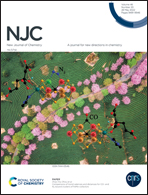Lawsone-bentonite hybrid systems for pH-dependent sustained release of ciprofloxacin†
Abstract
Development of safe, therapeutically active and economically affordable systems, which can interact and immobilize guest species is of paramount importance in drug delivery, and continuously leads to the discovery of new excipients. Clay based organic–inorganic hybrid materials are preferred over other inorganic matrices owing to the unique characteristic features of silica such as safety, eco-friendly nature, low cost, suitable thermal and chemical stability, non-corrosiveness, easy functionalization, and simple isolation from the reaction mixture. Herein, two biocompatible nanohybrid systems are presented and synthesized via a three-step procedure: Mannich reaction of lawsone using 4-cyanobenzaldehyde/1-pyrenecarboxaldehyde and chitosan, quaternization of a Mannich base and subsequent intercalation into bentonite clay generating the organic–inorganic hybrid systems. Confirmative evidence of Mannich reaction and quaternization was provided by FTIR results, while XRD, HRTEM and BET results demonstrated the formation of intercalated structures in QCB and QPB, which is further evident from percentage loading values, 17.27 and 11.63% respectively, obtained from thermograms. The porous hybrids are biocompatible (MTT assay) and have a pore size of 7 nm (QCB) and 5.3 nm (QPB) and proved their efficacy to serve as the matrix for loading ciprofloxacin (as a model drug) with 45.38% and 43.08% respectively, with a sustained in vitro release profile to be proposed as better alternatives for drug delivery applications.



 Please wait while we load your content...
Please wait while we load your content...